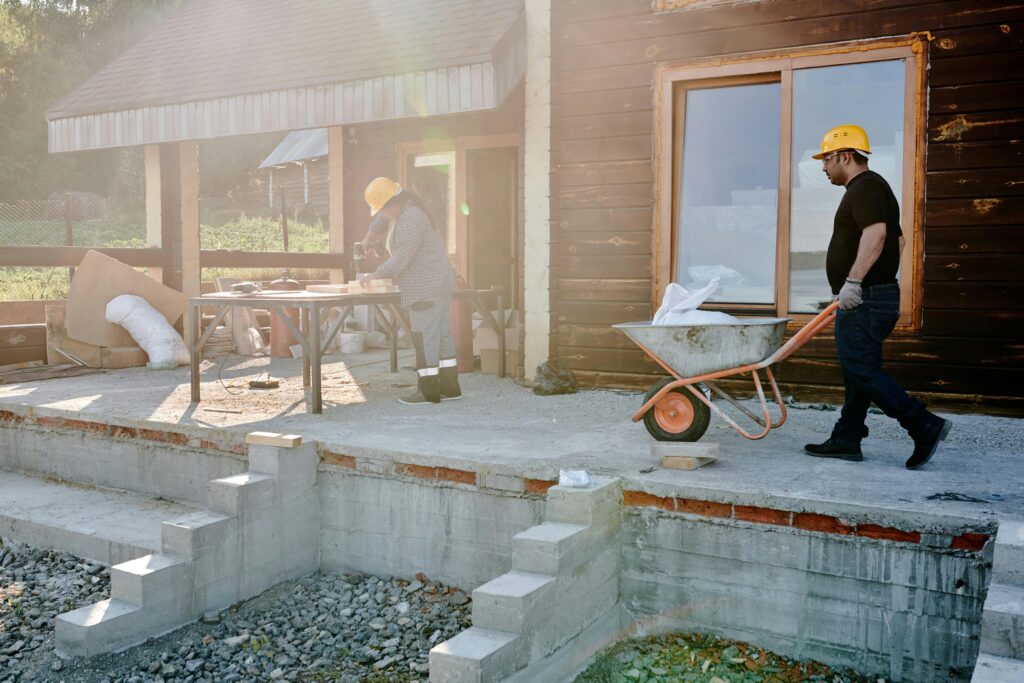Imagine this: you’re two weeks into your dream home remodel in Maryland, walls halfway down and the excitement palpable. Suddenly, a knock on the door reveals an unexpected visitor, a city inspector informing you that you’re missing the necessary permits, and now, your whole project is at risk of costly delays and fines. It’s a nightmare many homeowners and contractors face when they dive into remodeling without fully understanding the tangled web of permits and regulations.
If you’re planning a remodel in Maryland, this story is a crucial cautionary tale. Permits and regulations aren’t just bureaucratic red tape, they’re essential steps that protect your investment, ensure safety, and keep your project legally compliant. Yet, navigating Maryland’s legal requirements can be confusing and overwhelming without proper guidance.
In this article, you’ll learn everything you need to confidently manage permits and regulations for your Maryland remodel. From understanding when you need a permit, how to apply for one, to knowing the local building codes and inspections, this guide demystifies the process. We’ll walk you through the practical steps to avoid common pitfalls, streamline approval times, and keep your remodel on track and within the law.
By the end of this read, you’ll have a clear roadmap to navigate Maryland’s legal landscape for remodeling projects, ensuring your renovation journey is smooth, secure, and successful. Whether you’re a seasoned contractor or a first-time homeowner taking on a renovation, mastering permits and regulations is your foundation for a hassle-free remodel. Let’s get started.
Table of Contents
ToggleKey Takeaways
- Always verify which permits your Maryland remodel requires before work begins to avoid delays and fines.
- Structural, electrical, plumbing, and mechanical changes each need specific permits.
- Research local building codes, zoning laws, and historic district rules in your county or city.
- Submit complete applications with plans, fees, and contractor info to streamline approval.
- Schedule and pass required inspections at each project phase to maintain compliance.
- Keep organized records of all permits, correspondence, and inspection reports for future reference.
Why Understanding Permits and Regulations is Crucial for Your Maryland Remodel
When embarking on a home remodel in Maryland, one of the most critical steps you cannot afford to overlook is navigating the complex web of permits and regulations. Permits are official approvals granted by local government authorities that allow you to proceed with construction or renovation work. Regulations refer to the local, state, and federal laws governing how and when you can perform these projects. Understanding these legal requirements not only ensures your remodel is safe and up to code but also protects your investment and avoids costly fines or delays.
In Maryland, the importance of obtaining the right permits cannot be overstated. According to the Maryland Department of Housing and Community Development, over 70% of remodeling projects require some form of permit due to the safety, environmental, and structural concerns involved. Failing to secure these approvals can result in penalties, forced demolition of non-compliant additions, or complications when selling your home. In essence, permits and regulations act as a safeguard, ensuring that remodeling work protects the well-being of your family and the surrounding community.
Take, for example, the story of the Johnson family from Montgomery County. They decided to expand their kitchen and add an outdoor deck. Initially, they proceeded without securing the needed permits, eager to finish the project quickly. However, during a routine inspection for their home’s sale, the county flagged the unpermitted work. This resulted in a halt to the sale and a requirement to either obtain permits retroactively, which included costly inspections and modifications, or remove the addition entirely. The delay and extra expenses caused significant stress and financial strain to the family. Had the Johnsons understood the permit process from the start, they could have avoided these pitfalls entirely.
Moreover, these regulatory requirements are not arbitrary; they are designed to protect you and your neighborhood. For instance, building codes regulate structural integrity and fire safety standards, while zoning laws ensure your remodel fits within the neighborhood’s character and doesn’t infringe on property boundaries. Environmental regulations might control aspects like stormwater runoff or energy efficiency, which are especially relevant in Maryland due to its diverse ecosystems.
In summary, comprehending when and why you need permits and how regulations apply is the foundation of a successful Maryland remodeling project. This knowledge empowers you to plan effectively, stay compliant, and ultimately enjoy the benefits of a beautifully renovated, secure, and legally permissible home. In the next sections, we will delve into the specific types of permits required in Maryland and practical strategies to navigate the often-confusing legal landscape surrounding home renovations.
How to Navigate Permits and Regulations for Your Maryland Remodel Step by Step
Embarking on a remodeling project in Maryland can be both exciting and daunting, especially when it comes to understanding the legal landscape. Navigating the permits and regulations is a crucial step to ensure your remodel is compliant, safe, and hassle-free. Here’s a detailed, step-by-step guide to help you successfully manage the legal requirements for your Maryland remodel.
Step 1: Determine the Scope of Your Remodel
Before diving into permits and regulations, clearly outline the scope of your remodeling project. Are you planning minor cosmetic changes, such as painting and flooring, or major structural changes like adding a room or altering plumbing systems? Understanding the extent of your remodel will help you identify which permits are necessary.
– Cosmetic changes: Usually do not require permits.
– Structural changes: Typically need permits.
– Electrical, plumbing, mechanical work: Always require specialized permits.
Step 2: Research Local Building Codes and Regulations
Maryland’s municipalities may have unique rules depending on where you live, such as Baltimore City, Montgomery County, or Anne Arundel County. Visit your local building department’s website or office to review:
– Residential building codes
– Zoning laws
– Historic district regulations (if applicable)
– Environmental restrictions
Familiarizing yourself with these will help you avoid costly violations.
Step 3: Identify Required Permits for Your Remodel
Common permits needed in Maryland remodeling projects include:
1. Building Permit: For new construction, structural changes, or additions.
2. Electrical Permit: For any electrical work or upgrades.
3. Plumbing Permit: Necessary for plumbing alterations.
4. Mechanical Permit: For HVAC system modifications or installations.
5. Demolition Permit: If removing parts of the existing structure.
6. Historic Preservation Permit: Required in designated historic districts.
Step 4: Prepare Your Permit Applications
Gather all necessary documentation to streamline your permit application process:
– Detailed construction plans and blueprints
– Site plans showing property boundaries and structures
– Contractor information and licenses
– Proof of property ownership
– Any required impact studies (e.g., environmental or traffic)
Accurate and complete applications will reduce delays.
Step 5: Submit Your Permit Applications
Submit your applications to the relevant local authority, such as the Maryland Department of Labor, Licensing and Regulation or your county’s permitting office. Many jurisdictions offer online portals for permit submissions, making the process more convenient.
– Be prepared for application fees.
– Expect review times ranging from a few days to several weeks, depending on complexity.
Step 6: Schedule and Pass Required Inspections
Once your permits are approved and work begins, inspections ensure compliance throughout the remodeling:
– Foundation inspection
– Framing inspection
– Electrical and plumbing inspections
– Final inspection upon project completion
Failure to pass inspections could result in fines or the need to redo work.
Step 7: Keep Records and Stay Compliant
Maintain organized records of permits, correspondence, and inspections. This documentation can be crucial for future property sales or warranty claims and helps demonstrate that your remodel complies with Maryland’s legal requirements.
Practical Example: Remodeling a Kitchen in Montgomery County
Imagine you’re remodeling a kitchen that involves moving plumbing fixtures and upgrading electrical outlets. You would:
1. Confirm that you need plumbing and electrical permits.
2. Review Montgomery County’s building codes online.
3. Hire a licensed contractor who prepares detailed plans.
4. Submit permits via the county’s ePermitting portal.
5. Pay fees and schedule inspections.
6. Ensure inspections pass before proceeding to the next phase.
7. Keep all documents accessible until the project concludes.
By carefully following these steps, you can confidently navigate Maryland’s permits and regulations, avoiding legal pitfalls and ensuring your remodel is completed smoothly and to code. Remember, thorough preparation and adherence to legal requirements save time, money, and stress in the long run.
Tips to Navigate Permits and Regulations for Your Maryland Remodel 🏠⚖️
✅ Start Early with Permit Research: Before you swing a hammer, contact your local Maryland county or city building department to identify all required permits. Doing this upfront avoids costly delays.
✅ Understand Which Projects Require Permits: Not all remodels need permits. For example, cosmetic work like painting may not, but structural changes, electrical, or plumbing definitely do. Confirm specifics per Maryland codes.
✅ Hire Licensed Professionals: Maryland law often requires licensed contractors for certain remodels. Using licensed pros not only ensures compliance but also adds protection and expertise.
✅ Get Familiar with Maryland Code Updates: Regulations evolve. Check Maryland’s latest building codes and energy efficiency standards to avoid revisions midway through your project.
✅ Submit Complete and Accurate Applications: Incomplete permit applications cause frustrating delays. Double-check plans, documentation, and fees before submission to your local permitting office.
✅ Schedule Inspections Promptly: After permit approval, periodic inspections ensure your remodel meets legal and safety standards. Coordinate inspection appointments early to keep your timeline intact.
✅ Keep Records of All Permits and Correspondence: Store copies of permits, inspection reports, and communications safely. These records are crucial if you sell your home or face future compliance questions.
💡 Leverage Online Portals: Many Maryland counties offer online resources for permit tracking and applications. Using these digital tools can streamline your remodel process significantly.
❌ Avoid DIY on Permit-Required Work: Taking shortcuts without permits or licenses can result in fines, forced removals, or safety hazards. Always comply with Maryland’s legal requirements for remodeling.
Navigating Maryland’s permits and regulations for your remodel can seem daunting, but by following these practical tips, you’ll stay ahead of legal hurdles and build your dream space confidently.
Key Concepts
When embarking on a remodeling project in Maryland, understanding the intricate web of permits and regulations is akin to navigating a complex legal labyrinth. These concepts form the backbone of any successful home improvement venture and are vital not only for compliance but also for ensuring safety, quality, and long-term value. Let’s unravel the fundamental ideas that govern this process.
The Role of Permits: More than Just Paperwork
Permits function as official permissions granted by local authorities, signifying that your remodeling plans adhere to established codes and standards. One might liken a permit to a passport that allows your project to “travel” through the regulatory stages without hindrance. Without obtaining the proper permits, your remodel risks being halted mid-way or, worse, condemned for non-compliance, leading to costly fines or mandated undoing of the work.
In Maryland, permits aren’t a mere formality; they represent a rigorous checkpoint that ensures your remodeling aligns with building safety, zoning laws, and environmental guidelines. For example, adding a new room or altering electrical wiring without a permit is similar to driving without a license, possible, but fraught with danger and liability.
Regulations as the Framework of Safety and Order
While permits are the individual green lights for each aspect of your remodel, regulations serve as the comprehensive playbook outlining the dos and don’ts. Think of regulations as the rules of a complex game, designed not only to protect individual players (homeowners and contractors) but also to maintain the integrity of the entire neighborhood ecosystem.
Maryland’s building codes and zoning ordinances are examples of such regulations. They dictate everything from the height and placement of your home’s addition to the type of materials used, ensuring that safety isn’t sacrificed on the altar of convenience. These rules protect residents from structural failures, fire hazards, and environmental degradation.
The Interplay Between Local, State, and Federal Requirements
Navigating remodeling regulations is more than just dealing with the county or city permits. Maryland’s legal landscape for home improvements is multi-layered, comprising local municipal codes, statewide regulations, and, on occasion, federal laws. Each layer adds complexity but also clarity, think of them as nested security checkpoints that collectively guarantee the remodel’s legality and safety.
For instance, historic districts within Maryland may add additional layers of regulations to preserve architectural integrity, restricting certain modifications even if they meet basic building codes. This layered oversight ensures that individual projects harmonize with broader public interests, much like individual musicians tuning to the conductor’s notes in a symphony.
The Importance of Documentation and Inspections
Permits and regulations are not static elements but parts of a dynamic process involving documentation, inspections, and approvals. This cycle is comparable to the scientific method, where continuous evaluation confirms that each step meets required standards before proceeding further.
In Maryland remodeling, detailed plans must accompany permit applications, often accompanied by blueprints, structural analyses, or energy compliance certificates. After approval, inspections occur at different milestones, from foundational work to electrical installations, each inspection akin to a quality control checkpoint that can either greenlight the progression or flag issues for correction.
Legal and Financial Implications of Compliance
Beyond the technicalities, permits and regulations have profound legal and financial dimensions. Compliance acts as a shield against liability, protecting homeowners from lawsuits resulting from accidents, injuries, or damage caused by non-conforming work. Conversely, ignoring these requirements can result in legal battles, penalties, or loss of home insurance coverage.
Financially, adhering to these rules can actually enhance the value of your property, providing assurance to future buyers about the quality and legality of the work done. The analogy here is investing in certified, high-quality parts for a machine rather than cheap imitations; the former ensures longevity and trustworthiness, while the latter invites breakdowns and loss of value.
In essence, understanding permits and regulations is not merely about fulfilling bureaucratic demands. It is about appreciating a carefully constructed system designed to protect, empower, and guide Maryland homeowners through the complexities of remodeling. Viewing this system through the metaphor of a well-orchestrated symphony or a trusted roadmap reveals how these legal requirements ensure that every remodel is not just a physical transformation but a lawful, safe, and enduring one.
Frequently Asked Questions about Permits and Regulations: How to Navigate the Legal Requirements for Your Maryland Remodel
❓ What types of permits are required for a remodel in Maryland?
Depending on the scope of your remodel, common permits include building permits, electrical permits, plumbing permits, and mechanical permits. Larger projects, such as structural changes or additions, typically require more comprehensive permits.
❓ How do I apply for remodeling permits in Maryland?
You can apply for permits through your local county or city building department. Most Maryland jurisdictions offer online application portals, but you may need to submit detailed plans and pay associated fees.
❓ Can I start remodeling before getting the necessary permits?
No, starting work without the required permits can lead to fines, work stoppages, or having to undo completed work. Always secure permits before beginning your remodel to stay compliant with Maryland law.
❓ What inspections are required during the remodeling process?
Inspections vary based on the type of work but typically include framing, electrical, plumbing, and final inspections. These ensure that your project meets Maryland’s safety and building codes throughout the process.
❓ How can I ensure my remodel complies with Maryland regulations?
Hiring licensed contractors familiar with Maryland’s permitting process helps navigate legal requirements. Also, consulting with your local building department early on ensures you understand all necessary steps and avoid costly mistakes.
By understanding permits and regulations, you can confidently navigate the legal requirements for your Maryland remodel, ensuring a smooth and successful project from start to finish.



2 Responses